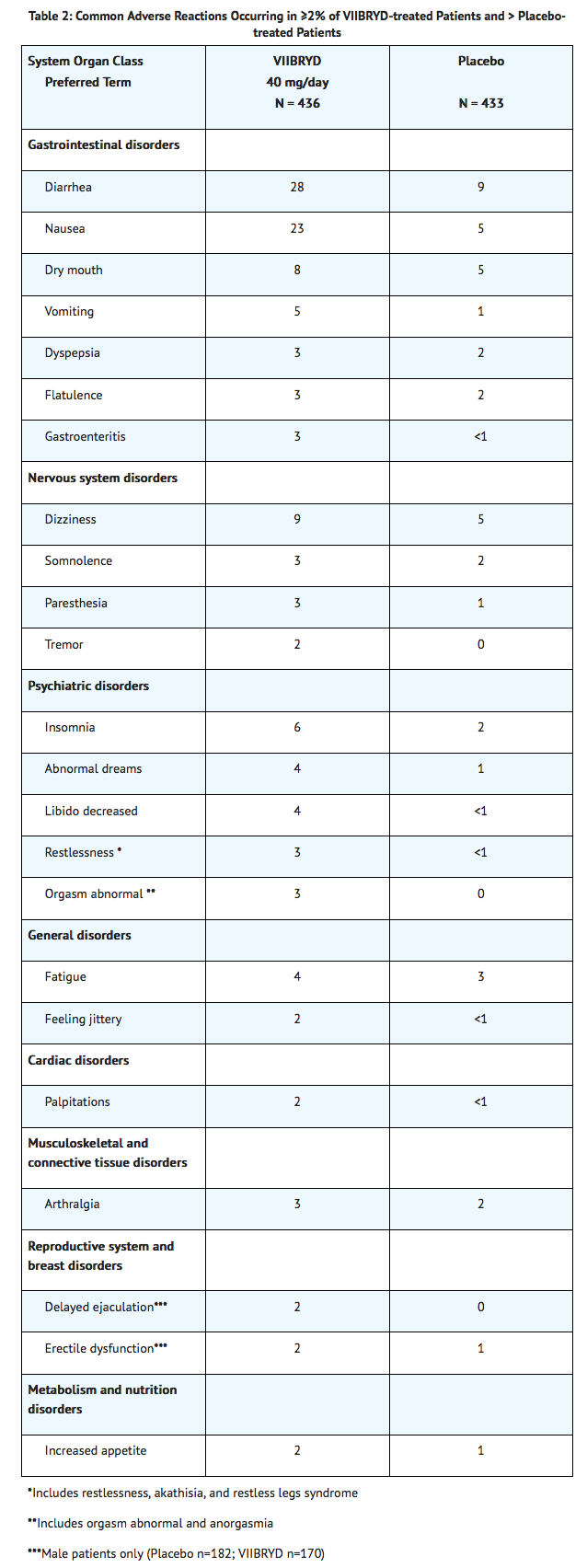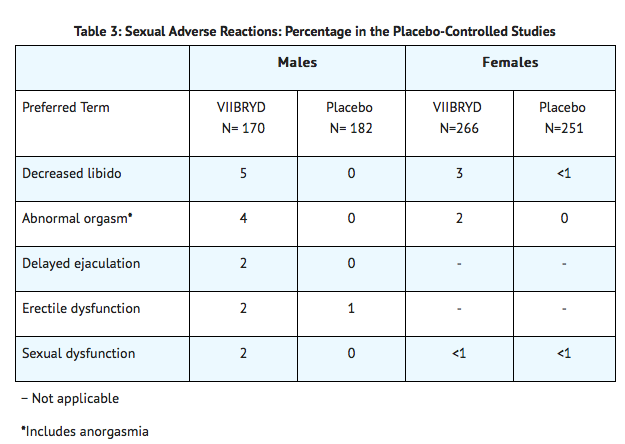Vilazodone: Difference between revisions
(Created page with "{{DrugProjectFormSinglePage |authorTag={{AP}} |blackBoxWarningTitle=<b><span style="color:#FF0000;">TITLE</span></b> |blackBoxWarningBody=<i><span style="color:#FF0000;">Condi...") |
No edit summary |
||
| Line 1: | Line 1: | ||
{{DrugProjectFormSinglePage | {{DrugProjectFormSinglePage | ||
|authorTag={{AP}} | |authorTag={{AP}} | ||
|blackBoxWarningTitle=<b><span style="color:#FF0000;"> | |genericName=Vilazodone | ||
|blackBoxWarningBody=<i><span style="color:#FF0000;">Condition Name:</span></i> | |aOrAn=a | ||
|drugClass=[[antidepressant]], [[serotonine agonist]] | |||
|indicationType=treatment | |||
|indication=[[major depressive disorder]] ([[MDD]]) | |||
|adverseReactions=[[diarrhea]], [[nausea]], [[vomiting]], [[xerostomia]], [[dizziness]], [[insomnia]]. | |||
|blackBoxWarningTitle=<b><span style="color:#FF0000;">SUICIDAL THOUGHTS AND BEHAVIORS</span></b> | |||
|blackBoxWarningBody=<i><span style="color:#FF0000;">Condition Name:</span></i> Antidepressants increased the risk of suicidal thoughts and behavior in children, adolescents, and young adults in short-term studies. These studies did not show an increase in the risk of suicidal thoughts and behavior with antidepressant use in patients over age 24; there was a reduction in risk with antidepressant use in patients aged 65 and older. | |||
In patients of all ages who are started on antidepressant therapy, monitor closely for clinical worsening and for emergence of suicidal thoughts and behaviors. Advise families and caregivers of the need for close observation and communication with the prescriber. VIIBRYD is not approved for use in pediatric patients. | |||
|offLabelAdultGuideSupport=There is limited information regarding <i>Off-Label Guideline-Supported Use</i> of Vilazodone in adult patients. | |offLabelAdultGuideSupport=There is limited information regarding <i>Off-Label Guideline-Supported Use</i> of Vilazodone in adult patients. | ||
|offLabelAdultNoGuideSupport=There is limited information regarding <i>Off-Label Non–Guideline-Supported Use</i> of Vilazodone in adult patients. | |offLabelAdultNoGuideSupport=There is limited information regarding <i>Off-Label Non–Guideline-Supported Use</i> of Vilazodone in adult patients. | ||
|offLabelPedGuideSupport=There is limited information regarding <i>Off-Label Guideline-Supported Use</i> of Vilazodone in pediatric patients. | |offLabelPedGuideSupport=There is limited information regarding <i>Off-Label Guideline-Supported Use</i> of Vilazodone in pediatric patients. | ||
|offLabelPedNoGuideSupport=There is limited information regarding <i>Off-Label Non–Guideline-Supported Use</i> of Vilazodone in pediatric patients. | |offLabelPedNoGuideSupport=There is limited information regarding <i>Off-Label Non–Guideline-Supported Use</i> of Vilazodone in pediatric patients. | ||
|contraindications======Monoamine Oxidase Inhibitors (MAOIs)===== | |||
The use of [[MAOIs]] intended to treat [[psychiatric disorders]] with VIIBRYD or within 14 days of stopping treatment with VIIBRYD is contraindicated because of an increased risk of [[serotonin syndrome]]. The use of VIIBRYD within 14 days of stopping an [[MAOI]] intended to treat psychiatric disorders is also contraindicated. | |||
Starting VIIBRYD in a patient who is being treated with [[MAOIs]] such as [[linezolid]] or intravenous [[methylene blue]] is also contraindicated because of an increased risk of [[serotonin syndrome]]. | |||
|clinicalTrials=The most commonly observed adverse reactions in VIIBRYD-treated MDD patients in placebo-controlled studies (incidence ≥ 5% and at least twice the rate of placebo) were: diarrhea, nausea, vomiting, and insomnia. | |||
=====Patient Exposure===== | |||
The safety of VIIBRYD was evaluated in 2,177 patients (18-70 years of age) diagnosed with MDD who participated in clinical studies, representing 552 patient-years of exposure. In an open-label 52 week study at 40 mg daily, 599 patients were exposed to VIIBRYD for a total of 348 patient-years. The information presented in these sections was derived from studies of VIIBRYD 40 mg daily in major depressive disorder including: 1) 2 placebo-controlled 8-week studies in 861 patients, including 436 receiving vilazodone; and 2) an open-label 52-week study of 599 patients. These studies included a titration period of 10 mg daily for 7 days followed by 20 mg daily for 7 days. In these clinical trials, VIIBRYD was administered with food. Because clinical trials are conducted under widely varying conditions and varying lengths of time, adverse reaction rates observed in the clinical trials of a drug cannot be directly compared to rates in the clinical studies of another drug and may not reflect rates observed in practice. | |||
=====Adverse reactions reported as reasons for discontinuation of treatment===== | |||
In the placebo-controlled studies of MDD there was no single adverse reaction leading to discontinuation in > 1% of the patients. Overall, 7.1% of the patients who received VIIBRYD discontinued treatment due to an adverse reaction, compared with 3.2% of placebo-treated patients in these studies. | |||
=====Common adverse reactions in placebo-controlled MDD studies===== | |||
Table 2 shows the incidence of common adverse reactions that occurred in ≥ 2% of VIIBRYD-treated MDD patients (and greater than in placebo-treated patients) in the placebo-controlled studies. | |||
[[file:AE Vilazodone1.png|none|400px]] | |||
[[file:SAE Vilazodone.png|none|400px]] | |||
|alcohol=Alcohol-Vilazodone interaction has not been established. Talk to your doctor about the effects of taking alcohol with this medication. | |alcohol=Alcohol-Vilazodone interaction has not been established. Talk to your doctor about the effects of taking alcohol with this medication. | ||
}} | }} | ||
Revision as of 14:43, 20 January 2015
Editor-In-Chief: C. Michael Gibson, M.S., M.D. [1]; Associate Editor(s)-in-Chief: Alberto Plate [2]
Disclaimer
WikiDoc MAKES NO GUARANTEE OF VALIDITY. WikiDoc is not a professional health care provider, nor is it a suitable replacement for a licensed healthcare provider. WikiDoc is intended to be an educational tool, not a tool for any form of healthcare delivery. The educational content on WikiDoc drug pages is based upon the FDA package insert, National Library of Medicine content and practice guidelines / consensus statements. WikiDoc does not promote the administration of any medication or device that is not consistent with its labeling. Please read our full disclaimer here.
Overview
Vilazodone is a antidepressant, serotonine agonist that is FDA approved for the treatment of major depressive disorder (MDD). Common adverse reactions include diarrhea, nausea, vomiting, xerostomia, dizziness, insomnia..
Adult Indications and Dosage
FDA-Labeled Indications and Dosage (Adult)
There is limited information regarding Vilazodone FDA-Labeled Indications and Dosage (Adult) in the drug label.
Off-Label Use and Dosage (Adult)
Guideline-Supported Use
There is limited information regarding Off-Label Guideline-Supported Use of Vilazodone in adult patients.
Non–Guideline-Supported Use
There is limited information regarding Off-Label Non–Guideline-Supported Use of Vilazodone in adult patients.
Pediatric Indications and Dosage
FDA-Labeled Indications and Dosage (Pediatric)
There is limited information regarding Vilazodone FDA-Labeled Indications and Dosage (Pediatric) in the drug label.
Off-Label Use and Dosage (Pediatric)
Guideline-Supported Use
There is limited information regarding Off-Label Guideline-Supported Use of Vilazodone in pediatric patients.
Non–Guideline-Supported Use
There is limited information regarding Off-Label Non–Guideline-Supported Use of Vilazodone in pediatric patients.
Contraindications
Monoamine Oxidase Inhibitors (MAOIs)
The use of MAOIs intended to treat psychiatric disorders with VIIBRYD or within 14 days of stopping treatment with VIIBRYD is contraindicated because of an increased risk of serotonin syndrome. The use of VIIBRYD within 14 days of stopping an MAOI intended to treat psychiatric disorders is also contraindicated.
Starting VIIBRYD in a patient who is being treated with MAOIs such as linezolid or intravenous methylene blue is also contraindicated because of an increased risk of serotonin syndrome.
Warnings
There is limited information regarding Vilazodone Warnings' in the drug label.
Adverse Reactions
Clinical Trials Experience
The most commonly observed adverse reactions in VIIBRYD-treated MDD patients in placebo-controlled studies (incidence ≥ 5% and at least twice the rate of placebo) were: diarrhea, nausea, vomiting, and insomnia.
Patient Exposure
The safety of VIIBRYD was evaluated in 2,177 patients (18-70 years of age) diagnosed with MDD who participated in clinical studies, representing 552 patient-years of exposure. In an open-label 52 week study at 40 mg daily, 599 patients were exposed to VIIBRYD for a total of 348 patient-years. The information presented in these sections was derived from studies of VIIBRYD 40 mg daily in major depressive disorder including: 1) 2 placebo-controlled 8-week studies in 861 patients, including 436 receiving vilazodone; and 2) an open-label 52-week study of 599 patients. These studies included a titration period of 10 mg daily for 7 days followed by 20 mg daily for 7 days. In these clinical trials, VIIBRYD was administered with food. Because clinical trials are conducted under widely varying conditions and varying lengths of time, adverse reaction rates observed in the clinical trials of a drug cannot be directly compared to rates in the clinical studies of another drug and may not reflect rates observed in practice.
Adverse reactions reported as reasons for discontinuation of treatment
In the placebo-controlled studies of MDD there was no single adverse reaction leading to discontinuation in > 1% of the patients. Overall, 7.1% of the patients who received VIIBRYD discontinued treatment due to an adverse reaction, compared with 3.2% of placebo-treated patients in these studies.
Common adverse reactions in placebo-controlled MDD studies
Table 2 shows the incidence of common adverse reactions that occurred in ≥ 2% of VIIBRYD-treated MDD patients (and greater than in placebo-treated patients) in the placebo-controlled studies.


Postmarketing Experience
There is limited information regarding Vilazodone Postmarketing Experience in the drug label.
Drug Interactions
There is limited information regarding Vilazodone Drug Interactions in the drug label.
Use in Specific Populations
Pregnancy
Pregnancy Category (FDA):
There is no FDA guidance on usage of Vilazodone in women who are pregnant.
Pregnancy Category (AUS):
There is no Australian Drug Evaluation Committee (ADEC) guidance on usage of Vilazodone in women who are pregnant.
Labor and Delivery
There is no FDA guidance on use of Vilazodone during labor and delivery.
Nursing Mothers
There is no FDA guidance on the use of Vilazodone in women who are nursing.
Pediatric Use
There is no FDA guidance on the use of Vilazodone in pediatric settings.
Geriatic Use
There is no FDA guidance on the use of Vilazodone in geriatric settings.
Gender
There is no FDA guidance on the use of Vilazodone with respect to specific gender populations.
Race
There is no FDA guidance on the use of Vilazodone with respect to specific racial populations.
Renal Impairment
There is no FDA guidance on the use of Vilazodone in patients with renal impairment.
Hepatic Impairment
There is no FDA guidance on the use of Vilazodone in patients with hepatic impairment.
Females of Reproductive Potential and Males
There is no FDA guidance on the use of Vilazodone in women of reproductive potentials and males.
Immunocompromised Patients
There is no FDA guidance one the use of Vilazodone in patients who are immunocompromised.
Administration and Monitoring
Administration
There is limited information regarding Vilazodone Administration in the drug label.
Monitoring
There is limited information regarding Vilazodone Monitoring in the drug label.
IV Compatibility
There is limited information regarding the compatibility of Vilazodone and IV administrations.
Overdosage
There is limited information regarding Vilazodone overdosage. If you suspect drug poisoning or overdose, please contact the National Poison Help hotline (1-800-222-1222) immediately.
Pharmacology
There is limited information regarding Vilazodone Pharmacology in the drug label.
Mechanism of Action
There is limited information regarding Vilazodone Mechanism of Action in the drug label.
Structure
There is limited information regarding Vilazodone Structure in the drug label.
Pharmacodynamics
There is limited information regarding Vilazodone Pharmacodynamics in the drug label.
Pharmacokinetics
There is limited information regarding Vilazodone Pharmacokinetics in the drug label.
Nonclinical Toxicology
There is limited information regarding Vilazodone Nonclinical Toxicology in the drug label.
Clinical Studies
There is limited information regarding Vilazodone Clinical Studies in the drug label.
How Supplied
There is limited information regarding Vilazodone How Supplied in the drug label.
Storage
There is limited information regarding Vilazodone Storage in the drug label.
Images
Drug Images
{{#ask: Page Name::Vilazodone |?Pill Name |?Drug Name |?Pill Ingred |?Pill Imprint |?Pill Dosage |?Pill Color |?Pill Shape |?Pill Size (mm) |?Pill Scoring |?NDC |?Drug Author |format=template |template=DrugPageImages |mainlabel=- |sort=Pill Name }}
Package and Label Display Panel
{{#ask: Label Page::Vilazodone |?Label Name |format=template |template=DrugLabelImages |mainlabel=- |sort=Label Page }}
Patient Counseling Information
There is limited information regarding Vilazodone Patient Counseling Information in the drug label.
Precautions with Alcohol
Alcohol-Vilazodone interaction has not been established. Talk to your doctor about the effects of taking alcohol with this medication.
Brand Names
There is limited information regarding Vilazodone Brand Names in the drug label.
Look-Alike Drug Names
There is limited information regarding Vilazodone Look-Alike Drug Names in the drug label.
Drug Shortage Status
Price
References
The contents of this FDA label are provided by the National Library of Medicine.